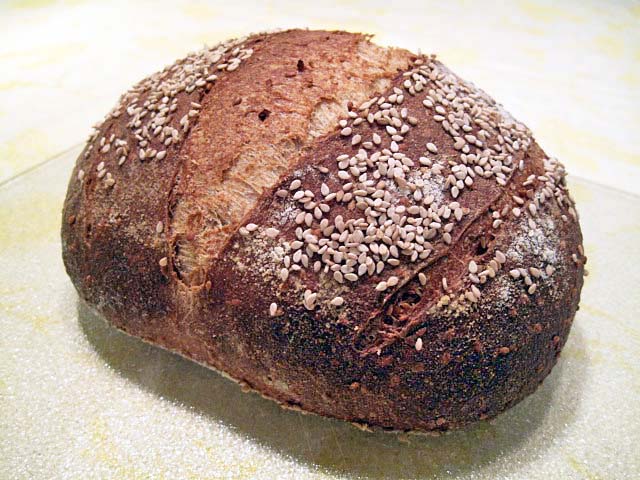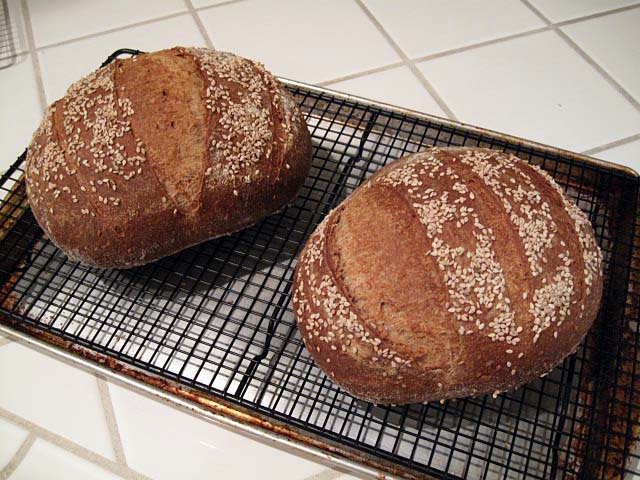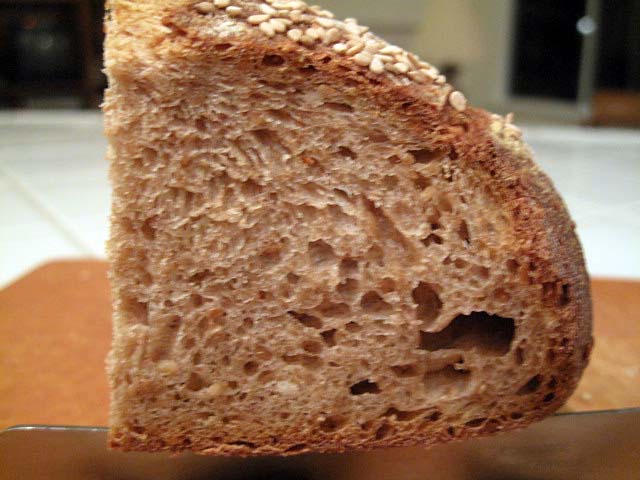
SD Psomi after Greenstein's "Psomi Bread"
On page 151-153 of Greenstein's “Secrets of a Jewish Baker,” there is a recipe for what he calls “Psomi Bread.” He says he had this from a bakery in New Hampshire and made his own version. His formula is as follows (The weights are my estimates. Greenstein only provides volume measurements.):
Sponge (150% hydration)
½ cup warm water (120 gms)
2 packages active dry yeast
1 ½ cups buttermilk or sour milk at room temperature (357 gms)
3 cups whole wheat flour, preferably stone ground (384 gms)
Dough (67% to 82% hydration, depending on am't of AP flour added)
4 tablespoons honey (84 gms)
2 tablespoons butter or shortening (24.5 gms)
2 to 3 cups unbleached all-purpose flour (266-399 gms)
2 teaspoons salt (9.24 gms)
½ cup toasted sesame seeds
Flour, for dusting work top
Oil, for greasing bowl
Additional sesame seeds, for topping (optional)
Shortening, for greasing pans
Procedures
Dissolve yeast in water. Add other sponge ingredients and mix. Cover and ferment for 45 minutes.
Mix dough ingredients into sponge using 2 cups AP flour. Mix and add more flour as necessary. In stand mixer, dough should clean bowl sides. Mix 8-10 minutes. Dough should be smooth and elastic.
Transfer dough to oiled bowl. Cover and ferment until double.
Divide dough into two equal pieces and preshape. Rest 10 minutes.
Shape into pan loaves or free form.
Proof until doubled. Score with 3 diagonal cuts and brush with water.
Bake in pre-heated 375ºF oven 35-45 minutes.
Brush again with water and cool on a rack.
Now, over the past year, I've been trying to find recipes that would produce the kind of Greek bread that my daughter-in-law has described having in Greece. About the first thing I learned is that the Greek word for bread is … Psomi. So, Greenstein's formula surely was for a bread of Greek origin. I gather he had no clue that he was making “Bread Bread.”
I also learned that the typical Greek village bread was always made with a sourdough and that it used whole-grain flour. Inclusion of fat – either lard or olive oil – was common, as was the addition of honey. Sesame seeds and at least some, if not all, durum flour were also commonly used.
So, looking at Greenstein's formula, I see he uses a yeasted sponge made with buttermilk or sour milk. I think it's safe to assume this was to acidify the dough to taste somewhat like sourdough would. I see Greenstein uses both AP and WW flour, but all the WW is pre-fermented. I decided to take Greenstein's recipe a step back towards it's presumed origin. More steps may follow in the future.
I also decided to apply some of what I'd learned about whole-grain bread baking from Peter Reinhart's books and used both a soaker and a levain and pre-fermented 25% of the total flour. Following Reinhart's formulas in “Whole Grain Breads,” I divided the whole wheat flour equally between a soaker at 87.5% hydration from milk and a levain at 75% hydration, with the seed culture 20% of the flour. I used my stock sourdough starter which, as it happens, is kept at 75% hydration. I also followed Reinhart's guidance and used 1.8% salt for the total dough, with some of the salt in the soaker (to inhibit enzymatic activity).
So, this is the formula I developed:
|
Levain |
Wt. (gms) |
Baker's % |
|
Whole wheat flour |
192 |
100 |
|
Water |
144 |
75 |
|
Active starter (75% hydration) |
38.5 |
20 |
|
Total |
374.5 |
195 |
|
Soaker |
Wt. (gms) |
Baker's % |
|
Whole wheat flour |
192 |
100 |
|
Milk |
168 |
87.5 |
|
Salt |
3.35 |
1.7 |
|
Total |
363.35 |
189.2 |
|
Final dough |
Wt. (gms) |
|
All of the levain |
374.5 |
|
All of the soaker |
363.35 |
|
Bread flour |
384 |
|
Water |
241 |
|
Honey (4 T) |
84 |
|
Olive oil (2T) |
24.5 |
|
Salt |
10.45 |
|
Toasted sesame seeds |
½ cup |
|
Total |
1481.8 |
Procedure
-
The night before baking, mix the soaker. Cover the bowl and leave at room temperature for 12 to 24 hours. (If not then ready to mix the final dough, the soaker can be refrigerated for up to 3 days.)
-
Mix the levain and allow to ferment until ripe (at least doubled and volume, with a domed top) – 4 to 6 hours. (This can be refrigerated for up to 3 days.)
-
If either (or both) the levain and soaker were refrigerated, take them out to warm to room temperature (about 1 hour) before mixing the dough.
-
Cut the levain and the soaker into about 12 pieces and put them in the bowl of a stand mixer together with the other ingredients. Mix with the paddle until they form a shaggy mass (1-2 minutes at Speed 1).
-
Switch to the dough hook, and mix to achieve moderate gluten development. (7 minutes at Speed 2)
-
Transfer the dough to a lightly oiled bowl, cover the bowl, and ferment until increased 50% in bulk with folds at 50 minute intervals. (About 2 ½ hours)
-
Divide the dough into two equal pieces and pre-shape into balls. Let the dough rest, covered for 10-15 minutes.
-
Shape the pieces into boules, batards or pan loaves and place them in bannetons or pans or on a couche.
-
Proof until increased 50% in bulk. (2 hours, 15 minutes in my kitchen at 72ºF)
-
While the loaves are proofing, pre-heat the oven to 425ºF with a baking stone in place and your steaming method of choice. (If baking pan loaves, the stone and steaming are not necessary.)
-
When the loaves have proofed, transfer them to a peel. Pre-steam the oven. Optionally, brush or spritz the loaves' surface with water and sprinkle with sesame seeds. Score the loaves. Traditional scoring for a boule is 3 transverse cuts. Transfer to the oven.
-
Steam the oven, turn the temperature down to 350ºF and bake for 40-50 minutes.
-
Transfer the loaves to a cooling rack and cool completely before slicing.


The crust was chewy and the crumb chewy but tender. The flavor was "sweet and sour whole wheat." It was actually pretty sour - more than my wife liked. I have made sourdough whole wheat breads before and did not enjoy the combination of whole wheat and sour flavors, but I did like this bread. This tasting was when the bread was just ... well ... almost cool. It will no doubt mellow by morning. I'm eager to taste it again after a good night's sleep.
Enjoy!
David
Submitted to YeastSpotting
- dmsnyder's Blog
- Log in or register to post comments
That is sensational David! I love how you marry three baking methods together, comes only from an experienced home baker.
I baked 50% wholewheat from hamelman yesterday, it came out very light, almost passes for a wonderbread!!
Mebake
David
I am glad to be back and have really missed your posts with their thoughtful details. In your iteration of the formula did you use plain milk or buttermilk ? It only says "milk". I like sour and wholewheat together so will look forward to trying your version. c
You were missed! I'm happy to see you back.
I used 2% milk. I figured Greenstein used buttermilk to get the sour flavor, and I was using a levain rather than a yeasted sponge, so I'd get the sour. And did I!
If I'd used buttermilk, I'd probably have credited it for how sour the bread is. In fact, I think the tanginess is from using a WW levain and cold retarding it for about 12 hours before mixing.
If I were to change the formula, I might use a bit less honey. If you do try my formula, I'd appreciate your feedback with any suggestions.
David
David,
I'll second your notion that much of the sour came from the WW levain. Some of the sourest breads I've made were either with a WW levain, or a WW bread with a levain. Something in the WW flour seems to boost the sour intensity of the finished bread. My experience is that the sour flavor will intensify, rather than mellowing, as the bread ages.
Interesting exercise, both in concept and in execution.
There are a lot of references to psomi on the web and I have no idea which recipe is "authentic". Here's one that mentions both sourdough starter and other-than-white flours.
Paul
I'd seen that recipe in my own searches. The comment about Greek breads being dense is a common theme. My bread was not at all dense. I followed Reinhart's guidelines for hydration. The Greek bread recipes I've found are typically 56-60% hydration, but use white flour. I may go for a lower hydration next time around.
It was pretty good for a "seat of the pants" try.
David
And very interesting bread forensics you did in reconstructing its' history and choice of ingredients!
Larry
My deconstruction of Greenstein's formula seemed logical, but that doesn't mean it's "true." I guess I'm going to have to take a bread tour of Greece.
David
The ends to which you'll go :>)
I read with interest your deconstruction of this loaf. Not surprised it was sour but it looks good to me. In search of the perfect Greek country bread.
Eric
I will definitely be giving it a try and let you know when I post. c
Great crumb, bread and all. Bet is tastes wonderful. Lovely pictures.
Ray
My starter is refreshed with 1/2 cup water and 1 cup flour. the formula calls for active starter 75% hydration. How much water & flour would equal 75% hydration?
I feed my starter with 1 part seed starter to 3 parts water to 4 parts flour.
Using Baker's percentages, the flour is always 100%. So, to get a 75% hydration starter, you would use 3 parts water to 4 parts flour. 3÷4=0.75 X 100 = 75%.
To calculate the amounts of ingredients in grams, notice that the fed starter has 8 (1+3+4) "parts." So, for example, to get 150 gms of active starter, you divide 150 gms by 8 parts and find that each part should weigh 18.75 gms. Thus:
Starter = 18.75 gms x 1 part = 18.75 gms
Water = 18.75 gms x 3 parts = 56.25 gms
Flour = 18.75 gms x 4 parts = 75 gms
Total = 18.75 gms x 8 parts = 150 gms
In practical terms, since your scale is probably not accurate to 1/100 of a gram, you round to the nearest gram in measuring.
I hope this helps.
David
Thanks so much. This definitley helps.